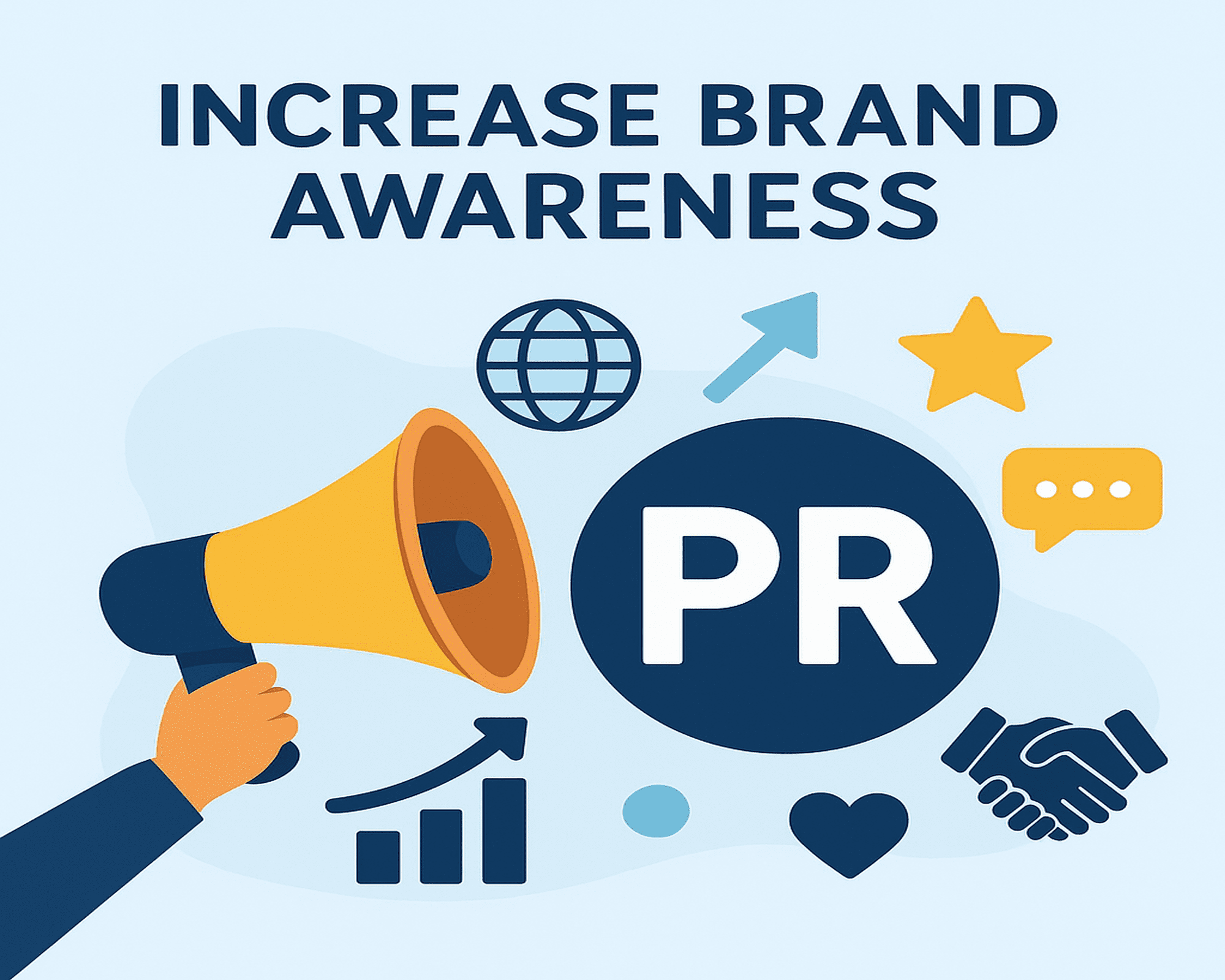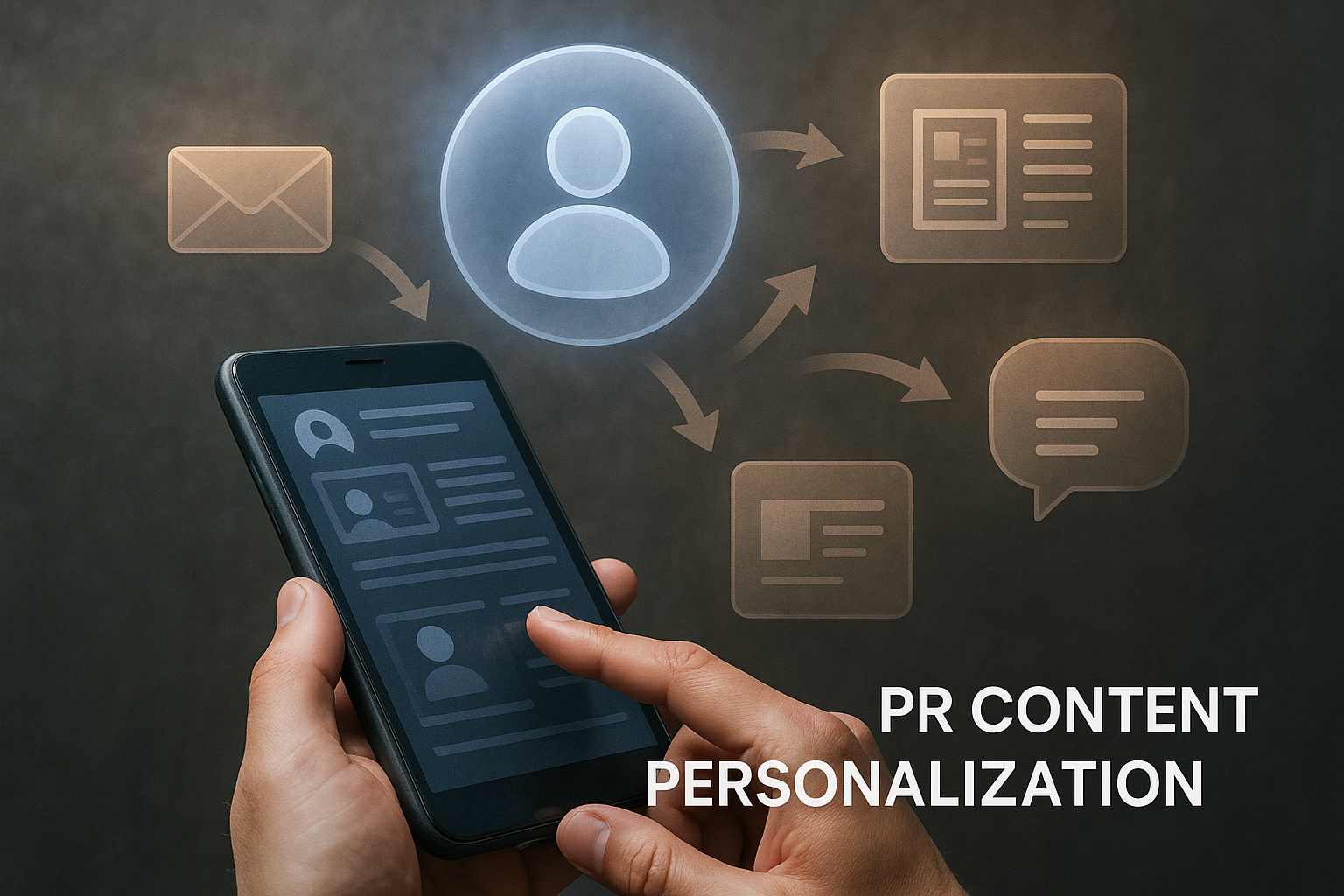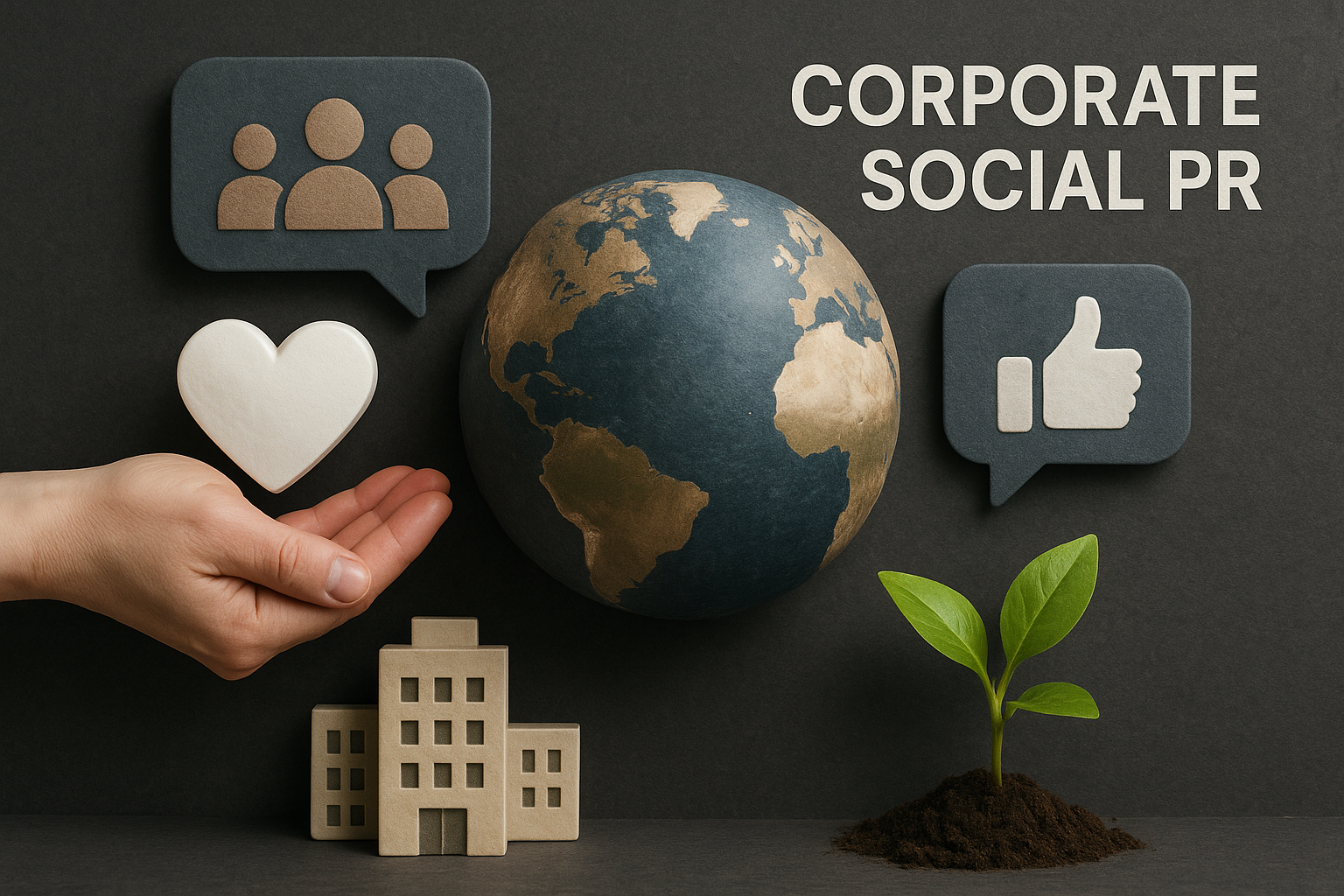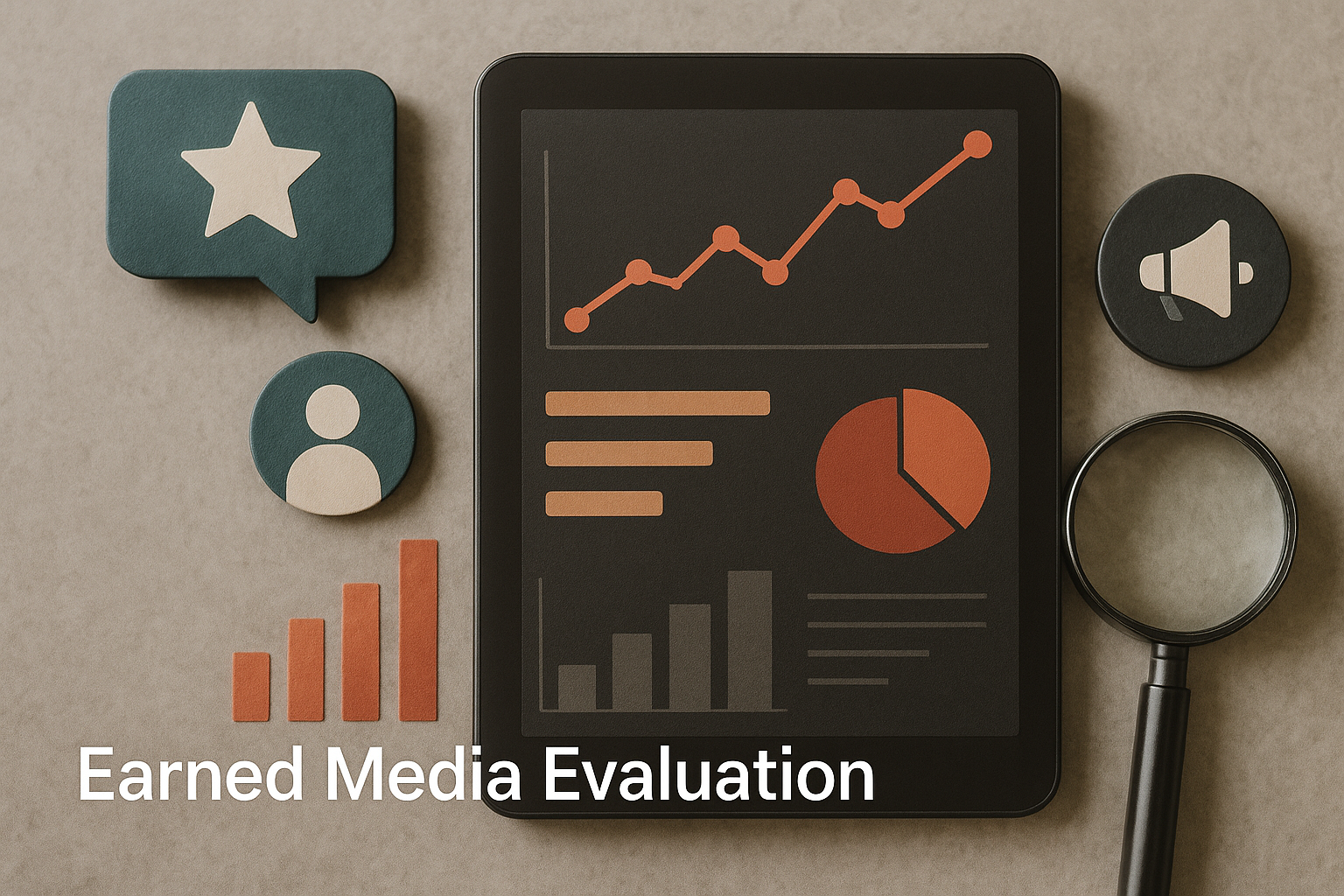From media features to reputation management, here’s how smart PR in 2025 transforms recognition into authority—and authority into growth.
Ever notice how some brands just stick in your mind, while others vanish the moment you look away? There’s a reason for that—and no, it’s not luck. It’s PR. But not the kind you’re thinking about. Forget press releases and media blasts that no one reads. I’m talking about the kind of PR that shapes perception, earns trust, and keeps people talking long after your campaign ends.
Brand awareness today isn’t just “people know your name.” It’s recognition, recall, and—most importantly—meaning. When someone thinks of your brand, what comes to mind? Do they see innovation, reliability, or maybe even a bit of charm? That’s what separates a brand that fades into the background from one that becomes part of the conversation.
Here’s the catch: attention is a scarce resource. Everyone’s shouting. Everyone’s chasing virality. And the internet? It’s basically Times Square on steroids—blinding, chaotic, and impossible to ignore. So how do you rise above that mess? That’s where smart PR comes in. Ads might get eyeballs, but PR earns respect. PR builds credibility. PR makes people believe in your brand—even when you’re not in the room.
Take a moment and think about a brand you love. Chances are, you didn’t just stumble upon it by accident. Maybe someone told you about it, you read about it online, or you noticed it being discussed in a conversation. That’s PR in action. And when it comes to travel brands, travel PR companies play a huge role in making that happen. It’s not just about visibility—it’s about building trust, establishing authority, and keeping the brand top of mind without ever needing to shout for attention.
In this article, we’re going to break down exactly how PR can increase brand awareness in 2025. We’ll dive into strategies that actually work, campaigns that resonate, media coverage that matters, and reputation moves that keep your brand solid when things get tricky. By the end, you’ll see why PR isn’t a nice-to-have—it’s the engine that powers growth, influence, and staying memorable in a noisy world.
Because here’s the truth: being seen isn’t enough anymore. You need to be remembered. And that’s exactly what good PR delivers.
Understanding Brand Awareness in the Modern Marketplace
Brand awareness. Sounds simple, right? People know your name, your logo pops up, done. But it’s really not that clean. There are layers, and most brands barely scratch the surface.
Think about it this way: there’s recognition, recall, and advocacy. Recognition is the “Oh yeah, I’ve seen that before” moment. Recall? That’s when someone thinks of your brand without a prompt. And advocacy… that’s the dream. That’s when someone’s actually telling their friends, “Hey, check this out, it’s legit.” Honestly, most companies stop at recognition and wonder why nothing sticks.
From Visibility to Credibility: How PR Builds Lasting Brands
Let’s be honest—by 2025, people don’t buy just because of an ad. They scroll past, delete emails, and the moment something feels fake, that brand gets stamped as annoying. The real currency now is trust. Authenticity, consistency, and a message that actually means something—that’s what makes people pause, pay attention, and maybe even engage.
And the noise. Oh man, the noise. Social media feeds that never end, blogs everywhere, content that’s basically shouting “pay attention to me.” It’s exhausting. Throwing money at ads isn’t going to cut through that. Visibility without credibility? That’s just yelling in a crowded room. Nobody remembers the loudest person—they remember the one who made sense, or made them feel something.
So yeah, credibility and positioning beat ad spend. Every time. Smart PR isn’t about screaming the loudest; it’s about showing up in the right places, saying the right things, and being believable. Do it right, and awareness grows on its own. Recognition turns into loyalty, loyalty turns into advocacy, and suddenly you’ve got a brand people actually care about.
Bottom line: brand awareness doesn’t happen by accident. You earn it. One real interaction, one well-placed story, one small moment at a time. And that’s the secret sauce PR brings to the table.
Image by Mohamed_hassan on Pixabay
Public Relations Strategies for Brand Visibility
Alright, let’s get something straight: visibility isn’t awareness. Big difference. Visibility is a neon sign blinking at you—hey, look! Awareness? That’s when someone actually remembers you. Weeks later. Months later. When they bring you up in conversation. That’s the sweet spot. Most companies? They just stop at blinking lights. And wonder why no one cares.
So how do you get from “oh yeah, I think I saw them” to “I need to tell my friend about them”? You guessed it: PR. But not the boring kind. The kind that actually works.
Storytelling and Narrative Control
People are wired for stories. Facts? Meh. Numbers? Forgettable. Stories? Sticky. So, don’t say, “We’re innovative.” Yawn. Say something that makes people feel something. How the founder pulled an all-nighter in a tiny apartment, or the weird problem your product finally solved, or the hot take that makes everyone nod and think, “Huh, they’ve got a point.” Control your story—or someone else will, and good luck with that.
Relationships with Media, Influencers, and Communities
PR is not a solo sport. Journalists, bloggers, podcasters, micro-influencers—they’re your megaphones. But don’t just spam them. (Seriously, don’t.) Show up. Engage. Help. Add value. Give them something worth their time, and slowly, almost magically, they start noticing. Communities work the same way: LinkedIn groups, niche forums, Reddit threads. Don’t just drop your brand like a billboard—actually be part of the conversation. Weirdly enough, that’s what gets attention.
Events, Podcasts, Thought Leadership Platforms
You don’t need a stadium or a huge ad budget. A small panel, a podcast guest spot, a virtual workshop—these can explode your visibility if done right. The trick? Consistency. Show up, show up again, then again. People remember repeated exposure in spaces they care about. It’s not sexy. It’s not flashy. But it works.
Case Example: Tiny Startup vs. Big Competitors
Real talk: a tiny startup we worked with had zero name recognition. And they were going head-to-head with giants. Could’ve thrown money at ads, sure, but guess what? Ads wouldn’t cut through the noise. So we went old-school and weird at the same time—crafted a punchy founder story, pitched them to niche podcasts nobody thought mattered, and built relationships with key bloggers. Six months later? Everyone in their niche was talking about them. They went from “who?” to “oh yeah, I’ve heard of them.” Visibility came first. Awareness followed. Advocacy was next.
The takeaway: visibility without strategy is just noise. Storytelling, relationships, smart platform use—that’s what turns a flicker into a spotlight. Otherwise? You’re just another blinking light in a very, very crowded room.
Media Coverage to Boost Brand Awareness
Let’s be clear: people don’t trust ads the way they once did. Paid campaigns? They grab attention, yes—but true influence comes from earned media. That’s when others talk about your brand: a journalist covering your story, a blogger highlighting your work, or a podcast host giving you a mention. Their endorsement tells audiences you’re worth noticing. This is where education PR services stand out. They help schools, universities, and edtech brands build credibility through trusted voices. And in today’s noisy world, nothing breaks through the clutter quite like that.
The media landscape today is… let’s just say it’s messy. Digital-first, always-on, fragmented into niche outlets, with creators running entire communities that brands used to dream of reaching. In 2025, global reach isn’t about a billboard in Times Square—it’s about appearing in the right place, with the right voice, at the right time. Podcasts, newsletters, micro-influencers, blogs—each of these tiny spots can have more impact than a national TV ad if your story hits.
So how do you actually get that coverage? How do you make media people want to talk about you instead of ignoring your email? A few things matter more than you’d think:
Compelling Press Releases
Please, spare the corporate jargon. No one wants to read a three-page manifesto of buzzwords. Keep it punchy, human, and focused on what’s actually newsworthy. Give them a story they can run with, not a brochure disguised as a press release.
Pitching to Journalists with Authority
Cold emailing random reporters? Meh. Target the ones who actually cover your space. Know what they write about, what angles they like, what stories resonate with their readers. And don’t just send a pitch—make it personal, relevant, and worth their time. Authority matters. Relevance matters more.
Guest Contributions and Interviews
Being featured in an article, podcast, or webinar isn’t just a vanity move. It’s a credibility play. Share insights, tell stories, be human. People remember voices and faces more than logos. Even a small feature in the right outlet can ripple out and create awareness in ways ads never will.
Case Study: Going Global Through Smart Coverage
Here’s one that sticks out. A mid-sized brand wanted international reach but had zero budget for mass ads. Instead, we focused on identifying niche media outlets in key markets, pitching thought leadership pieces, and securing interviews with relevant podcasts. Six months later? Their story appeared across three continents, and traffic and engagement spiked. Visibility turned into awareness, and awareness slowly morphed into credibility. Paid ads alone could never have achieved that level of trust.
Bottom line: in today’s market, media coverage is more than just exposure—it’s trust, it’s authority, it’s a way to punch through the noise without screaming. Done right, it positions your brand as someone people want to notice, remember, and talk about.
Image by Peggy_Marco on Pixabay
PR Campaigns for Brand Recognition
Here’s the thing: a one-off press mention? That’s not a campaign. That’s a lucky break. A PR campaign is intentional, coordinated, and—most importantly—strategic. It’s a series of moves designed to make your brand stick in people’s minds, not just flash for a moment and disappear. Think chess, not checkers.
Anatomy of a Successful Campaign
A good PR campaign has four moving parts that can’t be ignored:
1. Message – What story are you actually telling? This isn’t a tagline on a billboard. It’s the narrative that threads through every media mention, social post, and event. Clear, consistent, memorable.
2. Medium – Where are people going to see, hear, or read about you? Podcasts, blogs, niche forums, traditional outlets, social media—choose channels that match your audience. And yes, sometimes the weird, unexpected ones work better than the obvious.
3. Timing – A brilliant story released at the wrong time? Crickets. The market has rhythms, trends, and attention cycles. Hit the moment, and suddenly your message spreads like wildfire. Miss it, and it fades before anyone notices.
4. Measurement – How do you know it worked? Impressions, yes, but also engagement, social shares, mentions, sentiment. PR is not just a “feel-good” exercise—it’s data-driven, even if it doesn’t look like traditional marketing metrics.
Examples of Global PR Campaigns That Worked
Remember when that tiny sneaker brand got everyone talking by sending shoes to random influencers in a playful way? Or how a tech company staged a clever, interactive online event that journalists couldn’t resist covering? Those weren’t accidents—they were campaigns designed to maximize recognition through every touchpoint. The pattern is clear: narrative, placement, timing, repeat.
Integrating Traditional PR with Digital Channels
Here’s where most brands fumble. Traditional PR—press releases, media coverage, speaking engagements—still matters. But if you don’t amplify it digitally, it loses steam. Social posts, newsletters, micro-influencers, podcasts—they all extend your reach. Done together, you get a ripple effect: coverage feeds digital mentions, which feed awareness, which feeds credibility. It’s messy, yes, but when it works? Magnificent.
Bottom line: sporadic publicity gets you a moment in the spotlight. A coordinated PR campaign? It gets your brand remembered. And that’s the difference between being a flash in the pan and being a brand people can’t ignore.
Reputation Management for Stronger Branding
Okay, let’s get real. Reputation? That’s the stuff that lasts. You can have all the ads in the world, all the flashy campaigns, but if people don’t trust you… nothing sticks. Reputation is your brand equity. Long-term. Slow burn. The kind that keeps people coming back even when a new shiny competitor pops up.
Now, crises—oh boy, everyone hits them. Product flops, social media storms, bad press… it happens. And here’s the kicker: how you handle it? That’s what people actually remember. Don’t hide. Don’t spin. Be quick. Be honest. Say what’s going on, even if it’s messy. People forgive real humans, not suits hiding behind statements.
Then there’s the day-to-day stuff. Reputation isn’t just crisis mode. It’s:
- Keep your messaging consistent. Conflicting stories, mixed messages—total trust-killer.
- Be transparent. Yeah, share the messy parts too. People respect honesty over perfection.
- Show you care beyond profit. Thought leadership, giving back, doing something meaningful. It sticks. It makes people feel your brand is alive, not just a logo.
A quick example: one big global brand totally flubbed a product launch. Could’ve gone south fast. Instead? They went public, admitted mistakes, showed the fix in action, engaged with customers directly. Months later? People weren’t just talking about the brand—they were talking about how it handled it. Awareness? Fine. Trust? Stronger than ever.
So here’s the takeaway: PR isn’t just about being seen. It’s about being remembered for the right reasons. Get the awareness, yes, but pair it with credibility. That’s loyalty. That’s influence. That’s staying power.
Choosing the Right PR Partner
Okay, so here’s the tricky part. Picking a PR partner isn’t like picking a color for your logo. It’s more like… choosing someone to ride shotgun while you navigate a crazy, twisty road. You want someone who knows the terrain, who doesn’t freak out at bumps, and who actually gets you.
First, let’s clear up a common confusion: agencies, consultants, in-house teams—they’re not interchangeable. Agencies bring a full toolkit, teams of people, and connections. Consultants? Usually one or two folks with deep expertise, flexible, sometimes cheaper. In-house? You get loyalty, deep knowledge of your brand, but it’s all on you if something goes wrong. None is “better”—it’s about fit.
So, what do you actually look for? Here’s my short, honest list:
- Expertise – Do they know your industry, your audience, your kind of story? Or are they winging it?
- Industry fit – It matters. PR isn’t one-size-fits-all. A tech brand needs different angles than a lifestyle brand.
- Media relationships – Not just contacts. Real influence. Someone who knows which journalist actually cares about your story.
From Empty Promises to Proven Authority
Red flags? Yeah, there are a few. Overpromising (“We’ll get you on every major outlet in a week”), shady references, or a team that doesn’t actually understand your market. If it smells too good to be true, it probably is.
Now, here’s where Impact Authority does it differently. We don’t just chase visibility. That’s easy, anyone can spam a press release. We blend visibility with long-term authority—so your brand isn’t just “seen” for a second and forgotten. It’s remembered, trusted, and talked about. We focus on the long game: relationships, storytelling, credibility, repeatable wins.
Bottom line: picking a PR partner isn’t just about today’s headlines. It’s about tomorrow’s reputation. And, honestly, it’s worth taking your time to get it right.
Measuring PR Impact on Brand Awareness
Alright, here’s the thing. PR is one of those things everyone talks about, but no one really knows if it’s “working”—at least at first glance. You can get tons of mentions, traffic spikes, social chatter… but is anyone actually noticing? Are they remembering you? That’s what matters.
Metrics That Actually Matter
Forget vanity metrics. Likes, shares, impressions—they’re fun, but they don’t tell the whole story. The stuff that matters?
- Share of voice – How much of the conversation in your industry is actually about you? Not competitors, not noise. You.
- Sentiment – Are people talking about you in a good way, a “meh” way, or a “never again” way?
- Search trends – Are people actually looking for your brand online? That’s awareness in action.
- Traffic – Not just clicks, but meaningful engagement. Are they sticking around? Exploring your site?
Balancing Numbers With Stories
Here’s where most people get tripped up: metrics are numbers, but PR is also people. Those interviews, podcasts, guest articles—they create influence that numbers can’t fully capture. Qualitative outcomes matter too: trust, credibility, conversation. So you need both. Numbers give you the map. Stories give you the vibe.
Tools and Analytics in 2025
Tools are everywhere now. AI-powered dashboards, sentiment trackers, social listening platforms—you name it. But don’t get lost in shiny tech. Pick tools that tell a story, not just spit out numbers. You want insight, not a spreadsheet full of meaningless data.
Example: Calculating PR ROI
Quick example: imagine a campaign that got 50 media mentions, 20 podcast interviews, and 10 guest blogs. Traffic spiked 40%, search mentions doubled, and sentiment analysis shows 85% positive mentions. Compare the cost of running the campaign to the reach and influence you gained. Suddenly, PR isn’t just “soft power”—it’s measurable impact. You can actually say, “Yes, this moved the needle.”
Bottom line: measuring PR isn’t about obsessing over every tiny stat. It’s about finding the numbers that matter, mixing in the human side, and telling a story that proves your brand is being seen, remembered, and trusted.
Image by Visiventas on Pixabay
Future Trends: PR & Brand Awareness in 2025 and Beyond
Okay, let’s peek into the crystal ball for a second. PR in 2025? It’s not just press releases and conferences anymore. It’s… messy, exciting, fast, and a little wild.
AI in PR
Yes, AI isn’t just a buzzword here—it’s actually changing the game. Personalized campaigns, automated insights, predictive analytics… all of it helps brands hit the right people with the right story at the right time. But here’s the thing: AI can’t tell a story the way humans feel it. So the magic? Blend human creativity with AI precision. It’s like having a brilliant assistant who does the boring stuff while you focus on the spark.
Rise of Niche Influencers and Micro-Communities
Mass audiences? They’re still around, but the real engagement is happening in small, passionate communities. Micro-influencers, Discord groups, niche blogs—they’re the new frontlines. A single influencer with 5,000 super-engaged followers can move the needle more than a million passive eyeballs. Crazy, right? But it works.
The “Trust Economy”
Here’s the kicker: trust is currency. People are sick of fake news, fake hype, and fake personas. Brands that are transparent, fact-checked, and honest? They win. Simple as that. Your reputation isn’t just something nice to have—it’s a competitive advantage.
Content-Led PR
Longform articles, podcasts, interactive storytelling—they’re not optional anymore. People want depth, not just soundbites. If you can create content that’s meaningful, useful, or just genuinely entertaining, your PR wins on multiple levels: visibility, credibility, loyalty.
Sustainability and Values-Based PR
Finally, brands that show they care about more than profit—about people, planet, values—get remembered. It’s not greenwashing; it’s authenticity. Consumers notice when a brand actually walks the talk. And in 2025, that’s part of brand awareness too. People remember what you stand for, not just what you sell.
So yeah, the future is messy, fast, and way more human than you’d think. AI, micro-communities, trust, content, values—it all blends together. The brands that figure out how to ride this wave without losing their soul? Those are the ones people actually notice… and remember.
FAQs: PR & Brand Awareness
1. What’s the difference between PR and marketing for awareness?
Ah, this one trips people up all the time. Marketing is like shouting through a megaphone: ads, promotions, campaigns. PR? PR is like getting someone else to say, “Hey, check this out—it’s worth your time.” It’s earned credibility, not paid attention. Both boost awareness, but PR sneaks in trust along the way.
2. Is PR worth it for small businesses?
Short answer: absolutely. Long answer: yes, but it has to be smart. Small brands can’t outspend the giants. What they can do is tell a story, build relationships, and appear in the right spaces. One well-placed article, podcast feature, or local event can do more for recognition than a tiny ad budget ever could.
3. How long does it take for PR to show results?
Patience, my friend. PR isn’t instant noodles—it’s slow-cooked. Some visibility shows up quickly, sure, like a podcast or article mention. But real awareness? That can take months. Trust builds gradually. Relationships take time. If someone promises overnight fame… run.
4. Should PR be global or local?
Depends. Who is your audience? Local PR gets you known in your immediate market; global PR builds international credibility. Most smart brands do a mix. Start where you matter most, expand where it counts, and scale carefully.
5. Can PR replace advertising?
Nope. They’re buddies, not enemies. Ads buy attention. PR builds trust and credibility. Together? That’s the sweet spot. Separately? You can survive, maybe, but you won’t thrive. PR alone rarely drives immediate sales—but it makes everything else work better.
Conclusion: Building Awareness Through PR in 2025
Alright, let’s be real for a second. PR? It’s not just “hey, look at us” stuff. It’s the engine that quietly—sometimes annoyingly—makes people notice, remember, and actually trust you. Visibility, recognition, reputation—they’re all connected, like dominoes. Knock one down the wrong way and… well, you get the picture.
Every business, small or huge, needs this. Ads might grab attention for a hot second—pop, gone. Mix influence with impact—it sticks, it lingers, it makes people talk. And not just chatter, but meaningful chatter: “Oh yeah, I’ve heard of them. They seem legit. I trust them.” That’s the kind of awareness you can’t buy overnight.
Now, here’s where Impact Authority steps in. We don’t just toss press releases into the void and hope for magic. Nope. We build long-term authority, we craft stories people actually remember, we position brands where it matters, and we make connections that last. Short-term flashes? Sure. But the real payoff? Credibility that sticks, reputation that grows, influence that spreads.
So… are you tired of being just another blinking light in a sea of noise? Ready to actually matter? Let’s do it. Reach out to Impact Authority today. Let’s make your brand unforgettable. Not just seen. Not just talked about. Remembered. Trusted. Loved.




